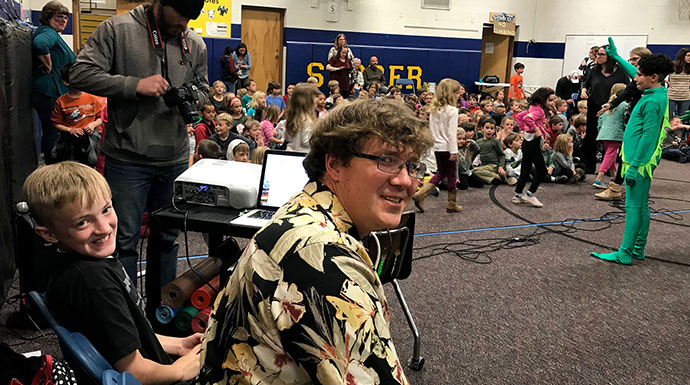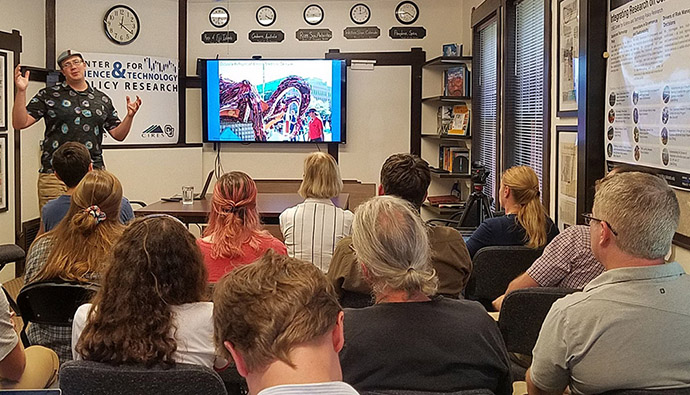If You Have No Hope, You Can’t Act: Patrick Chandler on Bridging Science and Artby Alison Gilchrist |
Patrick Chandler during a performance of Inside the Greenhouse’s musical for youth engagement, Shine, on Earth Day 2019. |
Halfway through my interview with Patrick David Chandler, a current Environmental Studies graduate student based at the Center for Science and Technology Policy Research (CSTPR), I told him that it felt like his career trajectory had been a straight line—that each job he has had was a natural progression from the one before it. “Oh no, definitely not a straight line,” Chandler said, laughing. “It’s been swirly.” But despite this protest, it seems that Chandler has naturally made a career out of caring about the natural world, wanting to educate people about these spaces, and incorporating art into his life. Immediately after college, Chandler worked as a professional raft guide in Santa Fe, New Mexico. But he quickly became more focused on the educational aspect of the trips he was leading. “The places where I was finding value, the trips I enjoyed most, were those where I got to engage people about the human and natural history of the area,” said Chandler. “So, I transitioned to environmental education.” Chandler moved to Homer, Alaska to work for the Center for Alaskan Coastal Studies and teach intertidal ecology and marine biology. Soon after, he was offered the position of Special Programs Coordinator, which included the role of International Coastal Clean-up Coordinator for the State of Alaska. His job was to provide resources and education for communities that wanted to be involved in research and clean-up of marine debris; he also recorded all of their data in the International Coastal Cleanup database. “That was incredibly emotionally taxing and intense work,” said Chandler, about the position. He explained that Alaska has over 40,000 miles of coastline, which is more than the rest of the United States combined, and very few people. A surface current pattern moves across the Pacific from Asia and another that moves up from the continental United States, so there’s a huge amount of plastic pollution and marine debris moving towards Alaska. The result of that ocean current is striking and horrible: “There were beaches that were a quarter to a half mile long where we’d pick up 10,000 pounds of plastic every year. Clean it completely, come back the next year, clean it again.” Chandler found that he was disappointed by the impact even his best efforts were having: “We weren’t really doing much as far as shifting the needle on awareness, on policy, and action. It just was an endless cycle of heartbreak.” Then he discovered Washed Ashore, a project devoted to making community-based art with washed-up debris from beaches. The art made something beautiful out of serious environmental problem, and brought new people into the conversation about marine debris. “I watched the way that people engaged with the work. It started conversations in a way that no amount of talking and data could possibly do.” Chandler became Education Director for the Washed Ashore Project, and toured the country with some of the sculptures, engaging people from all different backgrounds on the issue. At the same time, he was also talking to educators about the effectiveness of using art to talk about marine debris. “I kept getting the question: ‘can we do this here?’,” said Chandler. “No! And you shouldn’t do this here, you should get scientists, artists, and educators together in a way that enables your community to give voice to an issue that matters to them.” |
Patrick Chandler during a performance of Inside the Greenhouse’s musical for youth engagement, Shine, on Earth Day 2019. |
In other words, marine debris was a specific topic that Washed Ashore was tackling. Chandler is deeply aware that a project that connects scientists, artists, and the community must have community buy-in. Marine debris isn’t the issue that will necessarily spur community buy-in from places like Boulder or other cities, especially land-locked cities. Instead, scientists and artists should engage with their communities and ask for feedback on what issues are important to them. The process is iterative: scientists and artists can collaborate to create something that explains a scientific issue, and the community can respond with what worked for them. These ideas are the foundation of some of Chandler’s current dissertation work. Chandler won a CU Engage Graduate Fellowship in Community Based Research, and is currently designing a curriculum on climate communication with a team from the Inside the Greenhouse Project, CU Natural History Museum, and Jefferson County Schools for teachers, using the principles he learned with Washed Ashore. His goal is to work with teachers, and use their feedback iteratively, improving the curriculum and piloting it at new schools over the next few years. “We want to get to a place where teachers can pick it up and use it and it works without us,” said Chandler. “If you can’t do that, it’s pretty pointless for mass distribution.” Chandler also won a fellowship from the Nature, Environment, Science & Technology (NEST) Studio for the Arts, along with David Oonk. Together in partnership with the Inland Ocean Coalition, they are working on a project about microplastics in Rocky Mountain streams that they hope will educate the local community in an engaging way. Chandler is trying to impress upon locals that just because you can’t see the plastic pollution in places like Rocky Mountain National Park, doesn’t mean it isn’t there. “These pristine places… what is pristine?” he asked. “These beautiful streams and parks in Colorado: they’re still touched by our trash. We can’t be in a place that’s unaffected by our actions.” I asked Chandler what it feels like to work on issues (marine debris, microplastic pollution) that are so large, and that are very obvious signs of negative human influence. “It makes you feel hopeless,” admitted Chandler. “And the only way to move beyond that is to acknowledge and settle into the idea that we’re more than just the facts we compile. Through our creativity, through our intuition, through our emotion, we can create. And we will re-create the world in the next one hundred years, inevitably. So, it’s up to us if we’re going to do that intentionally.” Chandler thinks that this is why the arts are so important. “I’m not belittling the importance of science: we must have the wit and technology to enable some of the things that we can dream up and create. But if we lose the idea that we can create a new paradigm, that we can shift this polluted sphere we live in to be sustainable—if you don’t believe that, you have no hope. And if you have no hope, you can’t act.” Chandler has been guided through several jobs by the principles of art, engagement, and education. The result is an impressive series of creative and artistic projects that have brought more people into the conversation surrounding climate and pollution. He may describe his career trajectory as “swirly,” but sometimes the best art is a little bit swirly. |
 Alison Gilchrist Alison Gilchristalison.gilchrist@colorado.edu CSTPR Science Writing Intern |



